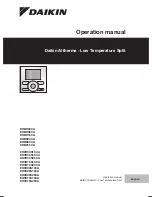
18
| Operation Manual C 2214 | Start up
6 Start up
6.1 Leakage test
Before starting the chlorinators a leakage test of all plant components must be carried out. Make sure that
both, plant components under overpressure and plant components under vacuum, are tested.
WARNING!
Before each leakage test, make sure to check your personal protective equipment.
6.1.1 Overpressure lines
For vacuum regulators directly installed to the cylinder, the overpressure system is limited to the cylinder con-
nection and the inlet valve. For all other systems, the piping system to the vacuum regulator must be checked.
Before each leakage test, make sure to check your personal protective equipment.
For the leakage test, open the chlorine cylinder slowly and close it again. Check all connection points with
ammonium vapour (=ammonium hydroxide solution). One can either carry out slow pumping movements with
the ammonia bottle in the proximity of the connection or hold a cloth soaked with ammonia close to the con-
nection. Leaking chlorine gas and ammonia form a clear visible white dust. If the first test was successful, the
cylinder may now be fully opened and checked again with ammonium vapour.
NOTICE!
Make sure that no ammonium drops on units. This leads to a strong chemical attack. A reaction is only visible
with the gas! Should any drops get on the units, make sure to remove them immediately with a cloth.
Due to the high corrosivity of humid chlorine gas all leaking points rapidly aggravate in the course of time.
Therefore even the smallest leakage must be removed immediately.
6.1.2 Vacuum lines
Leaking vacuum lines are not noticed during normal operation as chlorine gas does not escape but only ambi-
ent air is primed. However, at the same time humidity enters the piping system forming deposits along with
the chlorine gas. This is why vacuum lines must also be leakage-tested carefully. Switch on the ejector while
the cylinder valve is closed. After a short period of time the ball in the flow meter will not move anymore. If it
does, a leakage test of all components including the vacuum regulator must be carried out in order to remove
the leaking point. Make sure that no water penetrates the vacuum line after switching off the ejector.Water
penetrates the vacuum line only if the ejector non-return valve doesn't work perfectly. For troubleshooting of
the individual components, please also see paragraph 9, Maintenance.
6.2 Starting the system
For starting the plant the chlorine cylinder main valve must be opened first. Then the injection valve and the
motive water supply must be opened. In the case of perfect operation conditions, a vacuum is produced in
the ejector and will be transmitted via the non-return valve and the vacuum line to the vacuum controller thus
opening the chlorine inlet valve. The pressurized chlorine gas is reduced to vacuum in the inlet valve. The
chlorine gas flow is adjusted using the needle valve of the flow meter and can be read off at the top edge of
the ball. With automatic control systems the regulating valve is first arrested to 100 % opening and the chlorine
gas flow is then adjusted using the manual valve. As soon as manual samples indicate a chlorine content in the
treated water the measuring system is calibrated and the plant switches over to automatic operation.
















































